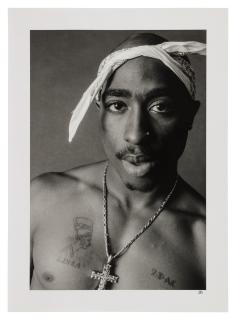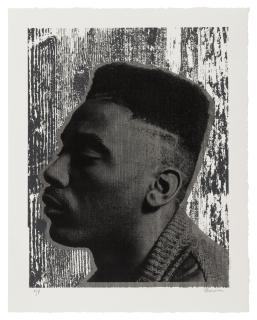Phase 2
[Logo Sculpture], 2002.
Estimate: 40.000 - 60.000 USD
Price realised: 40.320 USD
Price realised: 40.320 USD
Description
PHASE 2
[LOGO SCULPTURE], 2002.
Three-layer, dual-sided relief sculpture (4 x 8 ft). Spraypaint on plywood, with acrylic skulls and bubbles attached to panels.
From his distinctive flyers promoting parties in the Bronx, to his masterful aerosol calligraphy, to being one of the first writers to begin making the move from subway cars to canvas, Phase 2 was as influential as he was enigmatic.
He was also known as a sometime D.J., dancer and a founder of the New York City Breakers crew, and an emcee. In the late 1970s, Phase 2 was a member of a crew called the Wizards, and in 1982 released a pair of singles, “The Roxy” (the storied nightclub for which he did flyers) and “Beach Boy.” Charlie Ahearn, the director of the 1983 film “Wild Style,” has said that Phase 2 was the basis for the film’s main character, Phade (played
His restless and ever-evolving artwork laid the groundwork for a growing inner-city culture that became a worldwide phenomenon. A first-generation ‘writer’ with roots in the NYC subway art movement, he was an innovator of what he called “wild lettering.” In 1972 he pioneered the “softie” (bubble) letter used in the earliest subway “pieces” and introduced arrows, curls, twists and other connections that became universal visual elem
From rap’s beginnings, Phase 2 was present, from the park jams to the clubs. He rhymed and chanted with his original crooning style rap flow. Through his dance crew, Electrified Movement, he introduced the B-boy world to battle (up) rocking and other styles. He assembled one of the most important B-boy crews (The New York City Breakers).
He elevated the aesthetic of Hip Hop flyers with his often imitated “funky nous deco” style, introducing the “whole drawing” concept - thick marker borders and thin ink lines to construct connecting geometric shapes to mirror theater marquees and a syncopated placement of various fonts and sizes of press type; original ink drawings, photo collages, silhouettes and wordsmith slogans were part of his trademark style.
Phase 2 formed a decade partnership with IGTimes, the premiere, international street art publication where he edited, art directed and wrote critically about the culture. In 1996 his book, Style: Writing from the UnderGround was published. In 1994 he received the “Source Award” for his significant contribution to the culture.
[LOGO SCULPTURE], 2002.
Three-layer, dual-sided relief sculpture (4 x 8 ft). Spraypaint on plywood, with acrylic skulls and bubbles attached to panels.
From his distinctive flyers promoting parties in the Bronx, to his masterful aerosol calligraphy, to being one of the first writers to begin making the move from subway cars to canvas, Phase 2 was as influential as he was enigmatic.
He was also known as a sometime D.J., dancer and a founder of the New York City Breakers crew, and an emcee. In the late 1970s, Phase 2 was a member of a crew called the Wizards, and in 1982 released a pair of singles, “The Roxy” (the storied nightclub for which he did flyers) and “Beach Boy.” Charlie Ahearn, the director of the 1983 film “Wild Style,” has said that Phase 2 was the basis for the film’s main character, Phade (played
His restless and ever-evolving artwork laid the groundwork for a growing inner-city culture that became a worldwide phenomenon. A first-generation ‘writer’ with roots in the NYC subway art movement, he was an innovator of what he called “wild lettering.” In 1972 he pioneered the “softie” (bubble) letter used in the earliest subway “pieces” and introduced arrows, curls, twists and other connections that became universal visual elem
From rap’s beginnings, Phase 2 was present, from the park jams to the clubs. He rhymed and chanted with his original crooning style rap flow. Through his dance crew, Electrified Movement, he introduced the B-boy world to battle (up) rocking and other styles. He assembled one of the most important B-boy crews (The New York City Breakers).
He elevated the aesthetic of Hip Hop flyers with his often imitated “funky nous deco” style, introducing the “whole drawing” concept - thick marker borders and thin ink lines to construct connecting geometric shapes to mirror theater marquees and a syncopated placement of various fonts and sizes of press type; original ink drawings, photo collages, silhouettes and wordsmith slogans were part of his trademark style.
Phase 2 formed a decade partnership with IGTimes, the premiere, international street art publication where he edited, art directed and wrote critically about the culture. In 1996 his book, Style: Writing from the UnderGround was published. In 1994 he received the “Source Award” for his significant contribution to the culture.
A top price for Phase 2 - as previously expected
In September 2020 Sothebys in New York held the auction Hip Hop, which included the work Logo Sculpture, 2002. by Phase 2. The estimated price for the artwork was previously given by the auction house with a range of USD 40,000.00 – 60,000.00, the actual price achieved of USD 40,320.00 (€ 34,408.60) could thus just exceed the lower estimate. Even if this result could not surprise positively, Logo Sculpture, 2002. is the most expensive artwork by Phase 2 that we have observed at auctions so far.
Ein Spitzenpreis mit Ansage
Im September 2020 führte Sothebys in New York die Auktion Hip Hop durch, in der auch die Arbeit Logo Sculpture, 2002. von Phase 2 zur Versteigerung kam. Der Schätzpreis für das Kunstwerk wurde von dem Auktionshaus zuvor mit einer Spanne von USD 40.000,00 – 60.000,00 angegeben, der tatsächlich erzielte Preis von USD 40.320,00 (€ 34.408,60) konnte den unteren Schätzpreis somit knapp übertreffen. Auch wenn das Ergebnis damit nicht positiv überraschen konnte, ist Logo Sculpture, 2002. das teuerste Kunstwerk von Phase 2, das wir bisher bei Auktionen beobachtet haben.

![Phase 2 - [Logo Sculpture], 2002.](/images/phase-2_logo-sculpture-2002_AID176366.jpg?f=grey)





![Phase 2 - [Logo Sculpture], 2002.](/images/phase-2_logo-sculpture-2002_AID176366_320x320.jpg)















